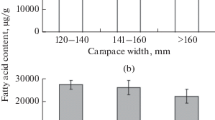Summary
The lipip content and composition of various tissues from three species of nototheniid fish from McMurdo Sound, Antarctic have been examined in relation to their habitat and buoyancy. The pelagic midwater Dissostichus mawsoni is neutrally buoyant. It is rich in lipid which is located subcutaneously, as adipose tissue associated intimately with white muscle, and as lipid droplets within the cells of various tissues. White muscle, red muscle and liver are particularly lipid-rich, although the liver is not positively buoyant. The amount of lipid stored in the white muscle increases towards the centre of buoyancy of the fish. These deposits are documented at the anatomical, histological and ultrastructural levels. Tissues of Pagothenia borchgrevinki contain less lipid than D. mawsoni, but liver, red muscle and white muscle are still very rich in lipid. This species is cryopelagic, that is it spends most of the time in the water column just beneath the surface ice layer. It is not neutrally buoyant, but has a low weight in seawater. The tissues of the benthic Trematomus bernacchii contain only normal levels of lipid. The lipid class compositions of all three species are dominated by triacylglycerol, particularly when lipid contents are high. Serum lipids are an exception in containing high levels of the transport lipid sterol ester. The reason why Antarctic fish use triacylglycerols for buoyancy rather than was esters (as used by many myctophids) or squalene (as used by some sharks) is unclear.
Similar content being viewed by others
References
Andriashev AP (1964) On the composition and origin of the Antarctic pelagic fish fauna. In: Carrick R, Holdgate M, Prevost J (eds) Biologie Antarctique. Hermann, Paris, pp 271–272
Andriashev AP (1965) A general review of the Antarctic fish fauna. In: van Oye P, van Mieghem J (eds) Biogeography and ecology in Antaretica, Monogr biol, vol XV. Junk, The Hague, pp 491–550
Bligh EG, Dyer WJ (1959) A rapid method of total lipid extraction and purification. Can J Biochem Physiol 37:911–917
Butler JL, Pearcy WG (1972) Swimbladder morphology and specific gravity of myctophids off Oregon. J Fish Res Board Can 29:1145–1150
Childress JJ, Nygaard MW (1973) The chemical composition of midwater fishes as a function of depth of occurrence off southern California. Deep-Sea Res 20:1093–1109
Clarke A, Wickins JF (1980) Lipid content and composition of cultured Penaeus merguiensis fed with animal food. Aquaculture 20:17–27
DeVries AL, Fastman JT (1978) Lipid sacs as a buoyancy adaptation in an Antarctic fish. Nature 271:352–353
DeWitt HH (1971) Coastal and deep-water benthic fishes of the Antartic. In: Bushnell VC (ed) Antarctic map folio series, Folio 15. American Geographical Society, New York, pp 1–10
Eastman JT, DeVries AL (1981a) Buoyancy adaptions in a swimbladderless Antarctic fish. J Morphol 167:91–102
Eastman JT, DeVries AL (1981b) Hepatic ultrastructural specialization in Antarctic fishes. Cell Tissue Res 219:489–496
Eastman JT, DeVries AL (1982) Buoyancy studies of notothenioid fishes in McMurdo Sound, Antarctica. Copeia 1982:385–393
Fewster ME, Burns BJ, Mead JF (1969) Quantitative densitometric thin-layer chromatography of lipids using copper acetate reagent. J Chromatogr 43:120–126
Lin Y, Dobbs GH, DeVries AL (1974) Oxygen consumption and lipid content in red and white muscles of Antarctic fishes. J Exp Zool 189:379–386
Malins DC, Barone A (1970) Glycerol ether metabolism: regulation of buoyancy in dogfish, Squalus acanthias. Science 167:79–80
Neighbors MA, Nafpaktitis BG (1982) Lipid compositions, water contents, swimbladder morphologies and buoyancies of nineteen species of midwater fishes (18 myctophids and 1 neoscopelid). Mar Biol 66:207–215
Nevenzel JC, Rodegker W, Robinson JS, Kayama M (1969) The lipids of some lanternfishes (family Myctophidae). Comp Biochem Physiol 31:25–36
Nybelin O (1947) Antarctic fishes. Sci Res Norw Antarct Exp (1927–1928) 26:1–76
Ohno Y, Yano I, Waguri O (1976) Lipids and fatty acids of Antarctic giant fish (in Japanese). Antarct Rec 57:129–135
Sargent JR (1976) The structure, metabolism and function of lipids in marine organisms. In: Malins DC, Sargent JR (eds) Biochemical and biophysical perspectives in marine biology, vol 3. Academic Press, London New York, pp 149–212
Author information
Authors and Affiliations
Rights and permissions
About this article
Cite this article
Clarke, A., Doherty, N., DeVries, A.L. et al. Lipid content and composition of three species of Antarctic fish in relation to buoyancy. Polar Biol 3, 77–83 (1984). https://doi.org/10.1007/BF00258151
Received:
Accepted:
Issue Date:
DOI: https://doi.org/10.1007/BF00258151




